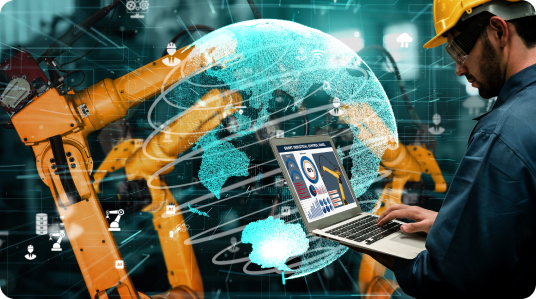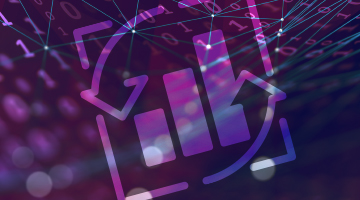Industrial IoT represents the next phase in the evolution of the Internet of Things, wherein smart manufacturers increasingly invest in connected physical products that have embedded computing devices in them in order to drive operational efficiency, reduce manual work, and otherwise accelerate business processes.
By connecting physical objects to the internet via industrial IoT investments, organizations can collect and transmit real-time data they can then use to make smarter business decisions and provide more value to their customers.
As an example, a healthcare company might use industrial IoT devices for remote patient monitoring. By keeping tabs on patients’ vital signs from afar, healthcare professionals can quickly determine at a glance whether an individual needs treatment or intervention—which, in turn, improves health outcomes.
Due to the powerful nature of the technology, organizations across all sectors including telecom, energy, manufacturing, retail, government, and industrial—stand to benefit from industrial IoT initiatives.
Table Of Contents
The Industrial IoT Opportunity
As the industrial IoT market continues to mature, more and more organizations are pumping serious money into enterprise IoT endeavors. While the global enterprise IoT market brought in $484 billion in 2020, that number is expected to reach $824.6 billion by 2027, growing 14.1% each year until then.
In large part, this growth can be attributed to the incredible opportunities industrial IoT promises, including:
- Streamlined workflows. Rather than having to manually input data into systems or physically check meters and other gauges to determine how equipment and other sensors are performing, all of this can be handled automatically by IoT gadgets. Not only does this reduce data-entry errors and improve data integrity, it also frees workers from having to spend their time on menial tasks.
- New revenue streams. Industrial IoT investments can also lead to lucrative new revenue streams. For example, mobile operators can use IoT devices to manage networks and applications in real time, which creates more opportunities to engage with customers (e.g., with in-the-moment upselling offers).
- Predictive maintenance. By monitoring mission-critical equipment in real time, industrial IoT solutions can also help organizations increase uptime by predicting when machinery might break down and proactively repairing it before that happens. According to Deloitte, enterprises will collectively save $630 billion by 2025 by using predictive maintenance to reduce unscheduled downtime.
Industrial IoT Trends
As more and more leading organizations make significant investments into the space, we’re starting to see a number of new industrial IoT trends emerge, which we’ll examine in this section.
5G
Unlocking the full promise of enterprise IoT investments requires lightning-fast connectivity. To this end, enterprises are increasingly investing in 5G networks to support real-time decisioning and make it easier to move and configure machinery thanks to ultra-wideband connectivity.
EDGE COMPUTING
As organizations increasingly invest in 5G and IoT, they’re also moving their workloads to the edge and using edge computing to accelerate data analytics and increase productivity. Over time, we expect to see edge computing investments continue to rise.
INDUSTRY 4.0
Industrial IoT promises to have a profound impact on many industrial organizations, including manufacturing, warehousing, and logistics companies. At a high level, the IoT will help these companies bake more efficiency into their operations, accomplishing more in less time and with fewer errors.
Industrial IoT Challenges
Though enterprise IoT technology delivers a ton of upside to organizations, it is not without its challenges. Here are some of the more pressing ones.
LATENCY
Making the most out of enterprise IoT infrastructure starts with removing as much latency from the decisioning process as possible. After all, what good is “real-time data” if you’re not able to analyze it in real time? For this reason, companies considering enterprise IoT investments need to look for data platforms that support actual real-time decision-making, with the ability to analyze and act on data in less than 10 milliseconds.
5G DEMANDS
Similarly, organizations can only expect to unlock the full promise of industrial IoT infrastructure if they have lightning-fast connectivity. This requires using data platforms engineered specifically for the moment at hand, with the ability to ingest and transmit millions of individual events each second.
SECURITY
As more devices are connected, bad actors have a wider attack surface to target. As a result, companies that invest in industrial IoT applications need to understand the new security risks they face—including more risk of data breaches, ransomware, and malware attacks—and take proactive steps to protect against them.
Data Platforms for Industrial IoT
Making the most out of the promise of industrial IoT requires a data platform built for the modern era. Such platforms need to be ACID-compliant, mesmerizingly fast, and wholly reliable. While NoSQL databases might be perfectly capable of handling workloads for applications like Netflix, Facebook, and LinkedIn, they can’t meet the data consistency and latency requirements enterprise IoT applications need.
We might be a bit biased, but we believe that the Volt Active Data platform is the ideal solution for organizations looking to unlock the full power of industrial IoT, 5G, and edge computing investments.
As the only platform that’s able to analyze and decide on data in less than 10 milliseconds due to a patented data integration process and battle-test in-memory database, Volt is becoming the go-to data platform for industrial IoT applications thanks to its speed, consistency, and scalability.
To learn more about how Volt Active Data can help your organization maximize its industrial IoT investments and soar to new heights, try our platform for free today.



